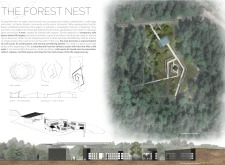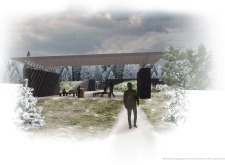5 key facts about this project
Unique Conceptual Framework
The project’s core concept revolves around the metaphor of a nest, symbolizing safety, nurturing, and the cycle of life. This metaphor manifests through the arrangement of spaces, which invite visitors to engage in moments of remembrance and reflection. Each architectural element is designed to enhance the visitor's experience, from the flowing shapes that mimic organic forms to the careful selection of materials that resonate with the surrounding environment. Unlike conventional memorial spaces, The Forest Nest encourages communal interaction and personal narratives, promoting healing through collective remembrance.
Materials and Design Integration
The design incorporates durable materials, such as concrete, glass, wood, and stone, each chosen for its relevance to the project’s overarching narrative. Concrete structures provide permanence, while glass elements facilitate transparency and light, connecting interiors with the outside. Wood elements create warmth, enhancing the emotional impact of the space, and stone pathways offer a tactile experience that aligns users with the natural terrain.
Attention to site-specific conditions is evident in the project's orientation and layout design. Strategic placement of windows allows for optimal natural light, while overhangs offer shelter and shade, adapting to seasonal variations. The project thoughtfully directs circulation, guiding visitors through the site’s winding paths, encouraging exploration and contemplation within the landscaped areas.
Community Engagement and Functionality
The Forest Nest is designed not only as a place for individual reflection but also as a venue for community gatherings. Different areas within the project cater to various functions, including ceremony spaces for memorial services and private reflection corners for solitude. The landscape design promotes communal interaction, with gardens and seating areas that foster collective engagement. This design choice distinguishes the project from typical memorial spaces, emphasizing a blend of personal and communal experiences.
For a comprehensive understanding of The Forest Nest, including its architectural plans, sections, and detailed designs, readers are encouraged to explore further details of the project presentation. Engaging with these elements will provide deeper insights into the architectural ideas and design methodologies employed in this unique project.


























